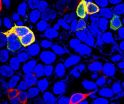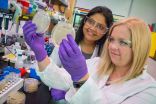EARTH Magazine: Tiny ants are heroic weathering agents
2014-11-05
(Press-News.org) Alexandria, Va. — Earth's abundant silicate minerals are degraded over time by exposure to water, chemical dissolution, and physical and chemical weathering by tree roots and even insects such as ants and termites. Such weathering plays a significant role in decreasing carbon dioxide in the atmosphere, as carbon dioxide is consumed in chemical weathering reactions and the resultant carbonate becomes sequestered in the form of limestone and dolomite.
To study the effects of weathering over time, researchers buried basalt sand at multiple test sites and dug up the samples every five years for 25 years to measure the degradation. What they found shocked them: Ants broke down the minerals 50 to 300 times faster than controls. What the ants are doing with the stone and whether the tiny titans' weathering prowess can be harnessed to draw down carbon dioxide levels remains to be seen. Read more in the November issue of EARTH magazine: http://bit.ly/ZHZsTc.
For more stories about the science of our planet, check out EARTH magazine online or subscribe at http://www.earthmagazine.org. The November issue, now available on the digital newsstand, features commentaries on how glaciation led to the U.S. Civil War, how the IPCC could have better communicated its findings to the public, and the lessons learned about hazard communication in the wake of Super-Typhoon Haiyan, which struck the Philippines last November, plus much, much more.
INFORMATION:
Keep up to date with the latest happenings in Earth, energy and environment news with EARTH magazine online at: http://www.earthmagazine.org/. Published by the American Geosciences Institute, EARTH is your source for the science behind the headlines.
The American Geosciences Institute is a nonprofit federation of 49 geoscientific and professional associations that represents more than 250,000 geologists, geophysicists and other earth scientists. Founded in 1948, AGI provides information services to geoscientists, serves as a voice of shared interests in the profession, plays a major role in strengthening geoscience education, and strives to increase public awareness of the vital role the geosciences play in society's use of resources, resiliency to natural hazards, and interaction with the environment.
ELSE PRESS RELEASES FROM THIS DATE:
2014-11-05
BUFFALO, N.Y. – Empathy is among humanity's defining characteristics. Understanding another person's plight can inspire gentle emotions and encourage nurturing behaviors.
Yet under certain circumstances, feelings of warmth, tenderness and sympathy can in fact predict aggressive behaviors, according to a recent study by two University at Buffalo researchers.
But why?
That an expression of kindness might be manifest as a punch in the nose can leave observers scratching their heads.
The answer is that it's not about anger or feeling personally threatened, says ...
2014-11-05
"New Rochelle, NY, November 5, 2014—The e-incubator, an innovative miniature incubator that is compatible with magnetic resonance imaging (MRI), enables scientists to grow tissue-engineered constructs under controlled conditions and to study their growth and development in real-time without risk of contamination or damage. Offering the potential to test engineered tissues before human transplantation, increase the success rate of implantation, and accelerate the translation of tissue engineering methods from the lab to the clinic, the novel e-incubator is described ...
2014-11-05
INDIANAPOLIS -- Indiana University School of Medicine researchers have identified a small protein with a big role in lowering plasma glucose and increasing insulin sensitivity. Their research appeared online today in Diabetes, the journal of the American Diabetes Association.
The report indicates that Sestrin 3 plays a critical role in regulating molecular pathways that control the production of glucose and insulin sensitivity in the liver, making it a logical target for drug development for type 2 diabetes and metabolic syndrome, which can produce increased blood pressure, ...
2014-11-05
Researchers from Northeastern University's Marine Science Center and the University of North Carolina at Chapel Hill have found that moderate ocean acidification and warming can actually enhance the growth rate of one reef-building coral species. Only under extreme acidification and thermal conditions did calcification decline.
Their work, which was published Wednesday in the journal Proceedings of the Royal Society B: Biological Sciences, is the first to show that some corals may benefit from moderate ocean acidification.
Justin Ries, an associate professor ...
2014-11-05
WASHINGTON, DC—November 4, 2014—An international team of bioengineers has boosted the ability of bacteria to produce isopentenol, a compound with desirable gasoline properties. The finding, published in mBio®, the online open-access journal of the American Society for Microbiology, is a significant step toward developing a bacterial strain that can yield industrial quantities of renewable bio-gasoline.
The metabolic engineering steps to produce short-chain alcohol solvents like isopentenol in the laboratory bacteria Escherichia coli have been worked on ...
2014-11-05
From water marks to colored threads, governments are constantly adding new features to paper money to stay one step ahead of counterfeiters. Now a longhorn beetle has inspired yet another way to foil cash fraud, as well as to produce colorful, changing billboards and art displays. In the journal ACS Nano, researchers report a new kind of ink that mimics the beetle's color-shifting ability in a way that would be long-lasting and difficult to copy.
Zhongze Gu, Zhuoying Xie, Chunwei Yuan and colleagues explain that some U.S. bills have color-changing features to help thwart ...
2014-11-05
Researchers from MIPT and the Weizmann Institute of Science (Israel) have predicted the possibility of negative turbophoresis, a phenomenon where impurity particles inside a turbulent flow move in an "impossible" direction. The study by Sergei Belan (a postgraduate at MIPT), Grigory Falkovich and Itzhak Fouxon was published in the journal Physical Review Letters in the Editors' Suggestions section, which features the most important and interesting studies from the editorial board's point of view.
The researchers studied the behavior of inertial particles in different ...
2014-11-05
An international study has devised a new measure for the "livability" of major cities across the world. The Global Liveable Cities Index (GLCI) takes into account the sensibilities of ordinary working people from 64 cities, balancing work and play, environmental awareness, localism, globalism and many other factors. Details are published in the World Review of Science, Technology and Sustainable Development.
According to Tan Khee Giap of the National University of Singapore and colleagues at University of California, Davis, and Curtin University, in Bentley, Australia, ...
2014-11-05
In a recent paper published in Nature Nanotechnology, Joel Moser and ICFO colleagues of the NanoOptoMechanics research group led by Prof. Adrian Bachtold, together with Marc Dykman (Michigan University), report on an experiment in which a carbon nanotube mechanical resonator exhibits quality factors of up to 5 million, 30 times better than the best quality factors measured in nanotubes to date.
Imagine that the host of a dinner party tries to get his guests' attention by giving a single tap of his oyster spoon on his crystal glass. Now, imagine, to the amazement of all, ...
2014-11-05
New Danish-led research suggests that signs of brain aging can be postponed in mice if placed on a high-fat diet. In the long term, this opens the possibility of treatment of children suffering from premature aging and patients with Alzheimer's and Parkinson's disease. The research project is headed by the Center for Healthy Aging, University of Copenhagen and the National Institute of Health.
When we get older, defects begin to develop in our nervous system, our brain loses some of its intellectual capacity, and the risk of developing diseases such as Parkinson's and ...
LAST 30 PRESS RELEASES:
[Press-News.org] EARTH Magazine: Tiny ants are heroic weathering agents






